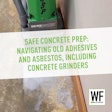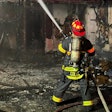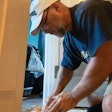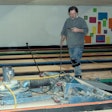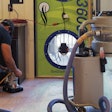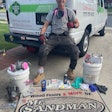

When your buddy slices his hand using the table saw, will you stand around dumbfounded or will you sprint to action, confident you know what do? You are aware of the most likely injuries on a wood flooring job site, but do you know which steps to take if they happen? Minor injuries can usually be treated with basic first aid or rest, but some injuries require a doctor's urgent care, and minimizing the time between accident and treatment is critical. Here we'll discuss some of the most common job site accidents and how to treat them immediately or prepare for a trip to the emergency room. Of course, when in doubt, always seek immediate medical attention.
Laceration
The Situation: Mark and Bryan are racking out a floor. The GC is way behind and is pressuring them to get the job done ASAP, so they are hurrying to complete the work as fast as possible. In his haste, Bryan gets careless with the table saw, resulting in a bad laceration.
What to Do: Cuts like this should be treated by applying direct pressure; take a bandage and press firmly on the wound. If you don't have a bandage handy, grab the nearest, cleanest piece of cloth you can find. After the bleeding stops, thoroughly clean the wound using soap and water. Popular perception says using an alcohol-based cleaner is best, but these products can cause pain and damage skin tissue, says Dr. Evan Ratner, owner/medical director at San Antonio-based Impact Urgent Care. What's more, soap and water is available almost everywhere, so it's better to just keep it simple.
When to Go to the Hospital: A wound that is more than ¼-inch deep, gaping or jagged-edged and has fat or muscle protruding usually requires stitches.
RELATED: First Aid on the Wood Flooring Job Site
Severed Finger
The Situation: The following week, Mark and Bryan are installing some ¾-inch oak strip. Mark's newborn baby kept him up all night, so he's a little drowsy today. He gets distracted while making a cut with the chop saw and cuts off part of his thumb from the top of the nail down.
What to Do: Again, the first thing to do is apply direct pressure on the cut in an effort to stop the bleeding. In this instance, though, it "might need to be significant pressure," Dr. Ratner says. Of course, someone will want to arrange for the injured worker to go straight to the ER. You'll want to also retrieve the severed portion as soon as possible and put it on ice. Dr. Ratner says the window to reattach this piece is "a few hours," but this varies significantly depending on the severity. Ultimately, a surgeon makes the final decision whether to reattach a finger, and sometimes may choose not to do so. "Sometimes when a digit is reattached, it doesn't have full function," Dr. Ratner says. A non-functioning finger is hazardous; if it's numb, you can't feel lacerations, burns or splinters (which could lead to infection), and it might get snagged on objects, which can endanger you further.
Allergic Reaction
The Situation: It's been a rough month for Mark and Bryan so far, but they truly love working with wood flooring-wouldn't change it for anything. This time the duo is doing a resand and finish job on some ipé in an upscale home in the suburbs. About an hour into the work, they both stop sanding. Mark shows Bryan his runny nose and watery eyes; Bryan shows Mark red blotches on his arms and neck-it looks like both men are having an allergic reaction to the wood dust.
What to Do: Immediately move into a well-ventilated area, most likely outside of the home. Cutting and sanding kicks a lot of dust into the air, which is a problem since wood dust is a known carcinogen. This problem is amplified when working with certain species, especially exotics, some of which can cause allergic reactions in certain people. It's possible to treat or head off minor allergic reactions with over-the-counter histamine-blocking drugs, like Benadryl and Zantac (the latter is actually an ulcer medication). "When you use them both together," Dr. Ratner says, "it really turns off the histamine response, which is responsible for the redness and itching typical of working with exotic wood flooring . . . If you know that every time you work with bubinga wood that you get itchy, sure, then go ahead and take [Benadryl and Zantac] beforehand." Benadryl can cause drowsiness; however, an alternative like Zyrtec can also counter minor allergic reactions without the sleepiness.
When to Go to the Hospital: For more serious allergic reactions-like facial swelling, trouble breathing or if you feel like your throat is closing up-you should take a Benadryl and see a doctor immediately.
To lessen the chances of having an allergic reaction to wood dust, maximize job site ventilation. "You want to get that air out of there because you don't just want it circulating on your skin," Dr. Ratner says. Long sleeves, dust masks and eye protection should always be worn when sanding wood flooring. You can perform a skin-patch test by placing a small amount of wood dust under a round adhesive bandage on the inside of your forearm. If a serious skin irritation is present when the bandage is removed after 24 hours, consider not working with that species.
Eye Injury
The Situation: Undeterred by the month's first aid episodes and trips to the hospital thus far, Mark and Bryan are working another install job; they're laying down an ornamental floor in a corporate lobby. While routing a path in the field for an aluminum inlay, a piece of wood shoots into Bryan's eye.
What to Do: Start by trying to flush the object from the eye with sterile saline-do not use Visine, Dr. Ratner says. Clean, lukewarm water is a suitable substitute if saline is unavailable. This is the same treatment if someone were to accidentally have finish splash into his eyes. In that case, though, you might need to resort to prolonged eye irrigation.
When to Go to the Hospital: If you're unable to flush the object from the eye using a saline solution, then it's time to go to the hospital. Evolutionarily speaking, your body has taken great lengths to protect your eyes-with eyelids, lashes and setting them deep within your skull behind protective bone-so when something intrudes on those organs, it's serious business. "Because eyes are really important, it's one of those things where you would err on the side of caution and just go to the ER," Dr. Ratner says.
Do not try to remove a foreign object embedded in the eyeball. In this instance, go directly to the ER. What's more, if the injured person is experiencing vision problems, or if pain persists even after you were able to remove a foreign object through flushing, a trip to the ER is in order.
Dr. Ratner says people who need to wear corrective eyewear should choose glasses instead of contact lenses while working with wood; a contact lens could entrap an irritant-dust or wood scrap-on the surface of the eye, which could then scratch the eye's outer layers. Also, sometimes an eye will become extra-sensitive to light if it is injured. In this case, you can close the eye, place a folded bandage on it, and then wrap an Ace bandage around your head to hold the eye closed. This should lessen your eye pain somewhat as you travel to the ER.
Back Strain
The Situation: Forging ahead despite much adversity, Mark and Bryan book a sanding job on the third floor of an apartment building. The first morning of the job, Bryan-who is 6' 4'' and 250 pounds-faces down the big machine: He bends his legs, hoists the machine up and plods up the stairs. Mark-who is 5' 11'' and a buck-seventy-watches and thinks he'll try the same thing. He stares down the big machine, flares his nostrils a little bit and hastily hunches over and grabs the thing, neglecting to bend his knees. "OOOOHHH-My back!" he screams.
What to Do: When you find a co-worker lying on the ground from having just strained his back, it's OK to move him to a more comfortable position (this is in contrast to injuries from blunt trauma, when a person should be stabilized to stave off further damage). "If you just twisted the wrong way or you lifted something heavy, movement might hurt, but shouldn't be dangerous," Dr. Ratner says.
When someone experiences an injury like this, rest is the best bet. Then, as soon as possible, return to normal activity. Seeing a doctor at some point can be a good idea to pinpoint the injury and diagnose further treatment, Dr. Ratner says. Of course, the best way to avoid an injury like this is to stay fit, stretch every morning before you start working and use proper lifting techniques.
When to Go to the Hospital: A trip to the ER or an urgent care facility is in order if you experience "new onset" pain, weakness or numbness in one or both of your legs after experiencing a back injury.
Electrocution

The Situation: It seems the worst is yet to come for our gallant duo. Mark and Bryan are tag-teaming another large sanding job, and as Mark begins his second pass, the lights flicker and the power goes out. Bewildered, he goes to search for Bryan in the other room. As he rounds a corner, he sees Bryan lying on the ground and realizes he's been electrocuted by touching an exposed wire in the cord of his big machine.
What to Do: First and foremost, neutralize the electrical hazard, whether you're dealing with an exposed wire or faulty tool. "Trying to yank someone off an electrical cord that is exposed is a pretty good way to double your number of victims," Dr. Ratner says. If you cannot neutralize the electrical hazard, move the source away from you and the victim using a non-conducting object, like a piece of wood. Do not move the victim unless he is in immediate danger. Next, check for signs of circulation (breathing, coughing or movement).
When to Go to the Hospital: If the person does not show any signs of circulation, call 911. Cardiopulmonary resuscitation (CPR) should be administered by a qualified individual immediately.
Heart Attack

The Situation: Mark and Bryan return to the job site after having lunch at a Mexican restaurant; they discussed job site safety over bean burritos and salsa. While he's applying the final coat of poly on a job, Mark starts to complain of a pain in his chest and shortness of breath.
What to Do: If you think you are having a heart attack, which might be the case if your chest pain lasts for 15 minutes or if you're experiencing shortness of breath, get to the ER immediately. In the meantime, take a regular-strength aspirin to help your blood flow through a narrowed artery. If the person experiencing a heart attack is unconscious, call 911. A qualified individual should perform CPR.
Reasons for chest pain are myriad, and determining the cause is difficult. It could be a serious medical emergency, such as a heart attack or pulmonary embolism, or it could just be due to indigestion (sometimes caused by eating spicy food).
An ER facility is capable of performing a cardiac catheterization, which is one of the most useful tools in diagnosing cardiac problems, according to the American Heart Association. There are myriad other tests and procedures that might need to be performed to determine cardiovascular problems, and an ER can perform them all, Dr. Ratner says. If you're working on a job in a rural area, it's better to call an ambulance over driving someone to the hospital since an ambulance is equipped with resuscitation devices. But if you must drive someone to the hospital who is experiencing chest pain or shortness of breath, it's best to prop them up in a passenger seat rather than having them lay down; having the person lay down might worsen his shortness of breath.
The More You Know
Emergency situations on the job site require quick thinking. It's best to do a little research in your market and find medical facilities in advance that can treat the common injuries of a wood flooring job site. "It might be the best way to make sure your workers get what they need fast," Dr. Ratner says. Depending on the type and severity of an injury, options include the hospital's ER or an Urgent Care facility. An urgent care facility cannot provide as many treatments as a hospital, but may still be a good option to deal with certain emergencies.
Of course, avoiding injury is the best job site prescription. If you make it a point to always wear personal protective equipment (PPE)-safety goggles, respirator, kneepads and earplugs-you can cut your chance of injury significantly. Also, ensuring your electrical cords are in good order, hooking up power safely, using proper heavy-lifting techniques and working safely with saws can further reduce your likelihood of injury. With this advice, hopefully you won't have a reason to chime in the next time you overhear a group of contractors exchanging stories about their table saw injuries.
Sources for this story included: Dr. Evan Ratner, Impact Urgent Care, San Antonio; Mayo Clinic; American Red Cross; and American Heart Association.
Ready for Anything

Just as it's important to have the right tool for the wood flooring job, having the right emergency care training could make a real difference on your job site. Having first aid and cardiopulmonary resuscitation (CPR) training could mean the difference between a minor injury and a major injury. For example, according to the American Heart Association, "Effective bystander CPR, provided immediately after sudden cardiac arrest, can double or triple a victim's chance of survival." What's more, invaluable equipment like an automated external defibrillator (AED)-which is used to treat abnormal heart activity in an emergency situation-is easy to operate. The American Red Cross offers training in first aid, CPR and AED administration, and the organization has chapters throughout the U.S. For information on courses in your area, visit www.redcross.org.
















